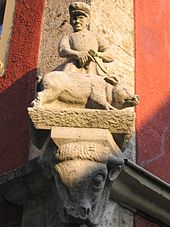Butcher
![]()
This article is about the profession. For the surname, see Fleischer (surname); for other meanings, see Fleischer (disambiguation).
![]()
Metzgermeister is a redirect to this article. See also: The master butcher : Deutscher Fleischer-Kurier
The butcher (common in central and eastern Germany), also butcher (southern and southwestern Germany, North Rhine-Westphalia, Switzerland, western Austria), slaughterer, butcher and kotter (northern Germany) and butcher and meat chopper (Austria), is an ancient craft. Butchers deal with slaughtering and with the production of meat and sausage products, they work in slaughterhouses and in butcher shops.

Butcher statue on the corner of a house in Rothenburg ob der Tauber

Master butcher and journeyman at the slaughter, engraving by Jost Amman, 16th century.

Production of liver sausage in Berlin (1948)
History
The first evidence of these activities was found among the Gauls, who made sausage.
In northern Germany in the Middle Ages, the butchers organized in guilds or guilds, who processed and sold the meat, were called Knochenhauer. In many towns, for example in Bremen or Hanover, there is still the street name Knochenhauergasse and Knochenhauerstraße, in Hildesheim the Knochenhaueramtshaus. The craftsmen responsible for slaughtering were called Küter (cf. Küterstraße in Kiel and - until 1940 - in Riga, Kütertor in Kiel, Lübeck, Stralsund, Rostock), because they received the entrails (mnd. küt) and head of the animals as wages. The traditional meat markets included the Fleischhalle Zürich.
The job description of the butcher has changed considerably in recent years. Today, the processing of meat has taken the place of slaughtering. As a result of this change in the profession and the associated concentration on a few slaughterhouses, the processing of meat still warm from slaughter for the production of scalded sausage, which was common until the 1970s, is almost no longer possible. For this, a close interlocking between slaughtering and processing is necessary, as the meat must be deboned, selected and processed within twelve hours.
Regional distribution of the designations
The designation butcher became the sole name of the trade in Germany in 1966, but it has not been able to displace the widely established designations butcher, slaughterer and meat chopper. Especially in southwestern and southern Germany as well as in Switzerland, Metzger has remained the predominant designation. In eastern Germany the profession is called butcher, in some areas also butcher. In northern German, the butcher is known as Schlachter (occasionally Schlächter); in Austria, Fleischhauer and Fleischhacker are the most common variants. The historical variants Knochenhauer or Metzler in southern Germany, on the other hand, are almost extinct.
Search within the encyclopedia